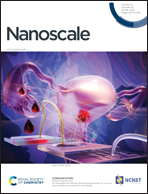Engineering novel surface electronic states via complex supramolecular tessellations†
Abstract
Tailoring Shockley surface-state (SS) electrons utilizing complex interfacial supramolecular tessellations was explored by low-temperature scanning tunnelling microscopy and spectroscopy, combined with computational modelling using electron plane wave expansion (EPWE) and empirical tight-binding (TB) methods. Employing a recently introduced gas-mediated on-surface reaction protocol, three distinct types of open porous networks comprising paired organometallic species as basic tectons were selectively synthesized. In particular, these supramolecular networks feature semiregular Archimedean tilings, providing intricate quantum dots (QDs) coupling scenarios compared to hexagonal porous superlattices. Our experimental results in conjunction with modelling calculations demonstrate the possibility of realizing novel two-dimensional electronic structures such as Kagome- and Dirac-type as well as hybrid Kagome-type bands via QD coupling. Compared to constructing SS electron pathways via molecular manipulations, our studies reveal significant potential of exploiting QD coupling as a complementary and versatile route for the control of surface electronic landscapes.



 Please wait while we load your content...
Please wait while we load your content...